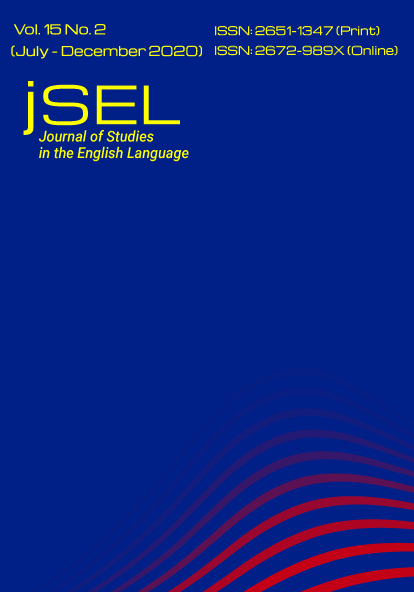The Link between Thai EFL Students’ Multiple Intelligences and Use of Vocabulary Learning Strategies
Main Article Content
Abstract
The roles of multiple intelligences (MIs) in language learning have attracted extensive consideration from previous researchers. MI reflects the learner's personality contrasts which were used as a device for individual learning. The studies related to the link between students’ MIs and vocabulary learning strategy (VLS) employment has been carried out in other countries; however, they seem scarce in the Thai context. The study purposed to examine the link between Thai EFL students’ multiple intelligences and the use of vocabulary learning strategies, and discover the VLS predictors. The 381 tertiary-level students in Nakhon Ratchasima Province took part in the study. MI questionnaire and vocabulary learning strategy questionnaire were used as tools. The results showed a low positive correlation between students’ MI profiles and their VLS employment. Furthermore, among diverse sorts of MI, verbal/linguistic intelligence was found to be a critical predictor of all VLS employment (cognitive, determination, memory, social, metacognitive, and affective strategies). The present study suggested EFL teachers strengthen their linguistic intelligence through learning activities and provide active vocabulary learning in a classroom.
Article Details
References
Ahour, T., & Abdi, M. (2015). The relationship between EFL learners’ multiple intelligences and vocabulary learning strategies use with a focus on gender. Theory and Practice in Language Studies, 5(4), 800-809.
Armstrong, T. (1999). Seven kind of smart: Identifying and developing your multiple intelligences. New York, NY: Penguin Putnam.
Armstrong, T. (2003). The multiple intelligences of reading and writing: Making the words come alive. Alexandria, VA: Association for Supervision and Curriculum Development.
Arnold, J., & Fonseca, M. C. (2004). Multiple intelligence theory and foreign language learning: A brain-based perspective. IJES, 4(1), 119-136.
Azadi, H., Abu Saeedi, A., & Zarafshan, M. (2014). The relationship between multiple intelligence and vocabulary learning strategies among Iranian EFL learners. International Journal of Language Learning and Applied Linguistics World, 6(2), 358-370.
Bintz, P. W. (2011). Teaching vocabulary across the curriculum. Retrieved from http://www.littoolkit.pbworks.com/f/Middle%20School%20Vocabulary%20St rategies.pdf
Boonkongsaen, M. (2014). English vocabulary learning strategies employed by Thai tertiary-level students (Unpublished doctoral dissertation). Suranaree University of Technology, Nakhon Ratchasima, Thailand.
Catalán, R. M. J. (2003). Sex differences in L2 vocabulary learning strategies. International Journal of Applied Linguistics, 13(1), 54-77.
Ellis, R. (1985). Understanding second language acquisition. Oxford, England: Oxford University Press.
Ellis, R. (1994). The study of second language acquisition. Oxford, England: Oxford University Press.
Farahani, K. A., & Kalkhoran, E. L. (2014). The relationship between incidental vocabulary learning and multiple intelligences of Iranian EFL learners. Theory and Practice in Language Studies, 4(1), 58-64.
Felder, M. R., & Brent, R. (2009). Active learning: An introduction. ASQ Higher Education Brief, 2(4), 1-5. Retrieved from https://www.researchgate.net/publication/242102584_Active_learning_An_introduction
Gardner, H. (1983). Frames of mind: The theory of multiple intelligences. New York, NY: Basic Books.
Gardner, H. (2011). Frames of mind: The theory of multiple intelligences (10th ed.). New York, NY: Basic Books.
Ghazal, L. (2010) Learning vocabulary in EFL contexts through vocabulary learning strategies. Novitas-Royal, 1(2), 84-91.
Harmon, J. M., Wood, K. D., & Kiser, K. (2009). Promoting vocabulary learning with the interactive world wall. Middle School Journal, 40(3): 58-63.
Krejcie, R. V., & Morgan, D. W. (1970). Determining sample size for research activities. Educational and sychological Measurement, 30, 607-610.
Mahdavi Zafarghandi, A., & Amini, S. (2019). The relationship between multiple intelligences and vocabulary learning strategies of intermediate EFL learners. Iranian Journal of English for Academic Purposes, 8(3), 65-76.
McKenzie, W. (1999). Multiple intelligences survey. Retrieved from https://www.kerstens.org/alicia/planning10/Multiple%20Intelligences%20Inventory.pdf
Oxford, R. (1990). Language learning strategies: What every teacher should know. New York, NY: Newbury House.
Oxford, R. L. (2003). Language learning styles and strategies: An overview. GALA, 1-25.
Panahi, A. (2012). From psychology of intelligence to the pedagogy of multiple-intelligences: Impact of spatial intelligence-based instruction on the vocabulary performance of EFL learners. Iranian EFL Journal, 8(2),128-142.
Razmjoo, S. A., Sahragard, R., & Sadri, M. (2009). On the relationship between multiple intelligences, vocabulary learning knowledge and vocabulary learning strategies among the Iranian EFL learners. The Iranian EFL Journal, 3, 82-110.
Rubin, J. (1987). Learner strategies: Theoretical assumptions, research history and typology. In A. Wenden & J. Rubin (Eds.), Learner strategies in language earning (pp.15-30). Englewood Cliffs, NJ: Prentice-Hall.
Schmitt, N. (1997). Vocabulary learning strategies. In N. Schmitt & M. McCarthy (Eds.), Vocabulary: Description acquisition and pedagogy (pp. 199-228). Cambridge, England: Cambridge University Press.
Schmitt, N. (2000). Vocabulary in language teaching. New York, NY: Cambridge University Press.
Siriwan, M. (2007). English vocabulary learning strategies employed by Rajabhat University students (Unpublished doctoral dissertation). Suranaree University of Technology, Nakhon Ratchasima, Thailand.
Sistani, M., & Hashemian, M. (2016). Investigating the role of multiple intelligences in determining vocabulary learning strategies for L2 learners. English Language Teaching, 9(6), 242-251.
Skourdi, S., Damavand, A., Viyani, A., & Kashef, S. H. (2012). On the relationship between linguistic intelligence and vocabulary knowledge among Iranian EFL learners. The Iranian EFL Journal, 8(6), 289-303.
Taghinezhad, A., Azizi, M., Shahmohammadi, S., Kashanifar, F. S., & Azadikhah, M. (2016). Comparing the effects of direct and indirect learning strategies on Iranian EFL learners’ vocabulary learning. Journal of Applied Linguistics and Language Research, 3(1), 133-143.
Wenden, A. (1987). Conceptual background and utility. In A. Wenden & J. Rubin (Eds.), Learner strategies in language learning (pp. 3-13). Englewood Cliffs, NJ: Prentice-Hall.
Wongyai, W., & Patphol, M. (2019). Learning management for enhancing growth mindset. Sikkha Journal of Education, 6(1), 52-60.


